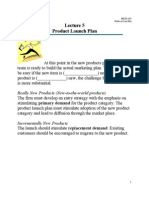Developing A GTM Strategy
Developing A GTM Strategy
Uploaded by
itsjuzmeksCopyright:
Available Formats
Developing A GTM Strategy
Developing A GTM Strategy
Uploaded by
itsjuzmeksOriginal Description:
Original Title
Copyright
Available Formats
Share this document
Did you find this document useful?
Is this content inappropriate?
Copyright:
Available Formats
Developing A GTM Strategy
Developing A GTM Strategy
Uploaded by
itsjuzmeksCopyright:
Available Formats
Developing a GTM Strategy
Developing a strong GTM strategy is hard to get right – especially for any startup in high-growth
mode. The right GTM requires bringing together all of the strategic assets that address your
business and growth strategy: sales, marketing, product, channel, brand, and vision.
The benefits of developing this kind of strategy are huge, but a lot of pieces have to come
together in order to properly prepare and ready your organization for investing in it.
What You Need to Know
Your customers are the lifeblood of your company, and they’re the only reason you can continue
to exist. Every product you build, every marketing message you craft, should be based on your
customers.
This is equally true for big companies and small companies.
How does your business connect with its customers? How do you deliver your unique value to
your target customers? How do you go from the initial connection with a potential customer to
the fulfillment of your brand promise?
The answer to these vital questions define your go-to-market strategy.
You probably already know this in theory, but in day to day operations, or in the development stages of
a company, sometimes this gets muddy. Knowing your customer is the first building block you must
master.You see, money isn’t always the issue when you’re struggling to grow. At times, big problems
surface due to over focusing on your product.Focusing too much on the technical aspects of the product
often leads to the lack of understanding what the customer really wants and needs.Addressing a
relevant need in the market only gives you the right to compete, it does not ensure success or
investment.The key to discovering, understanding, and satisfying your customer begins with asking the
right questions.You should have clear answers to questions like:
Who is your buyer?
Why would they buy a solution of any kind?
Why would they buy from you?
What is the solution to their problem that you specifically are providing?
You must know your customer. You must find a way to understand them.
Who is your target customer?
What is their targeted need?
Does what you’re providing meet their specific need?
What are the emotional pains and gains of your customer?
Remember no one buys a product, they buy a problem solved or a result achieved. If you fail to
communicate what problem you solve or result you enable, what you build may be a moot point.
You might also like
- Go To Market StrategyDocument49 pagesGo To Market StrategyGergana Valcheva100% (1)
- Go To Market StrategyDocument19 pagesGo To Market StrategyJasmine Sahoo100% (1)
- Go To Market Strategy Whitepaper FinalDocument15 pagesGo To Market Strategy Whitepaper FinalMEGNo ratings yet
- GTM JitoDocument20 pagesGTM Jitoankur.aroraNo ratings yet
- Braze EngagementDocument54 pagesBraze EngagementAlok BhattNo ratings yet
- Go To Market and Launch Planning GuideDocument20 pagesGo To Market and Launch Planning GuidechienNo ratings yet
- Go To Market Strategy Analysis FrameworkDocument1 pageGo To Market Strategy Analysis FrameworkmegafieldNo ratings yet
- GTM Strategy Leveraging Vicks Channels For Merck Brands: By: Rohit Singh Xlri - BMDocument5 pagesGTM Strategy Leveraging Vicks Channels For Merck Brands: By: Rohit Singh Xlri - BMRohit SinghNo ratings yet
- The Reality of Freemium in SaaSDocument23 pagesThe Reality of Freemium in SaaSCloudSafeNo ratings yet
- Go To Market StrategiesDocument23 pagesGo To Market StrategiesMarcNo ratings yet
- Saas Inside Sales ReportDocument0 pagesSaas Inside Sales ReportmawuseyNo ratings yet
- Marketing Mix Modelling - A CMOs HandbookDocument13 pagesMarketing Mix Modelling - A CMOs Handbookorlov orlviNo ratings yet
- 5 Product Launch PlanDocument10 pages5 Product Launch PlanAbhinav RanaNo ratings yet
- Go-to-Market & Scale - 2020-01-09 - Emin, Patrick, TessaDocument58 pagesGo-to-Market & Scale - 2020-01-09 - Emin, Patrick, TessaFounderinstituteNo ratings yet
- Outsourcing Playbook GDocument88 pagesOutsourcing Playbook GaasaNo ratings yet
- Go To MarketDocument17 pagesGo To MarketshabbirNo ratings yet
- SaaS Marketing Guide 2015Document64 pagesSaaS Marketing Guide 2015David Lara67% (3)
- Pitch DeckDocument20 pagesPitch DeckKldv PrasadNo ratings yet
- Pricing Your SaaS Product VFDocument35 pagesPricing Your SaaS Product VFEvelyn Ureta100% (1)
- (Google Interview Prep Guide) Associate Product Manager (APM)Document7 pages(Google Interview Prep Guide) Associate Product Manager (APM)Shrey Agrawal0% (1)
- Introduction To Market ResearchDocument30 pagesIntroduction To Market ResearchKamran AhsanNo ratings yet
- Go-To-Market Strategies Product Launch ChecklistDocument6 pagesGo-To-Market Strategies Product Launch ChecklistFadi100% (3)
- Marketing Automation ROI CalculatorDocument4 pagesMarketing Automation ROI CalculatorKaveri GuptaNo ratings yet
- B2B Marketing Automation Platforms Competitor Analysis, (Resulticks)Document23 pagesB2B Marketing Automation Platforms Competitor Analysis, (Resulticks)Jaya J100% (2)
- The Future of Sales: Dave Boyce - Chief Strategy Officer Chris Harrington - Chief Executive OfficerDocument12 pagesThe Future of Sales: Dave Boyce - Chief Strategy Officer Chris Harrington - Chief Executive OfficerOscar BravoNo ratings yet
- Go To Market Strategy-CreativeDocument14 pagesGo To Market Strategy-CreativeNahruddin MaiNo ratings yet
- Go-to-Market & Scale - 2020-01-09 - Emin PresentationDocument12 pagesGo-to-Market & Scale - 2020-01-09 - Emin PresentationFounderinstitute67% (3)
- GTM Strategy ProposalDocument2 pagesGTM Strategy ProposalNikita GulguleNo ratings yet
- Programmatic PosterDocument2 pagesProgrammatic PosterBorderBRENo ratings yet
- Cold OutreachDocument22 pagesCold OutreachmannedaksheprajNo ratings yet
- Competitive Analysis - How To Conduct A Competitive AnalysisDocument32 pagesCompetitive Analysis - How To Conduct A Competitive AnalysisHaroon AzizNo ratings yet
- GTM Motions PlaybookDocument43 pagesGTM Motions PlaybookUmut Gürkan100% (2)
- (Ebook) Retention Marketing For BeginnersDocument21 pages(Ebook) Retention Marketing For BeginnersFree Fire100% (1)
- How To Break Into Product ManagementDocument12 pagesHow To Break Into Product ManagementZafarNo ratings yet
- Strategic Marketing Interview Questions and Answers Guide.: Global GuidelineDocument9 pagesStrategic Marketing Interview Questions and Answers Guide.: Global GuidelineBlanca BlancaNo ratings yet
- Winning Pitch Decks: February 5, 2015Document50 pagesWinning Pitch Decks: February 5, 2015Rick WongNo ratings yet
- Chapter-Go To Market StrategyDocument12 pagesChapter-Go To Market StrategyAlan Wkfan100% (1)
- Gartner b2b Buyer's JourneyDocument7 pagesGartner b2b Buyer's JourneySangram SabatNo ratings yet
- The Ultimate Guide What Is ABMDocument16 pagesThe Ultimate Guide What Is ABMSaratNo ratings yet
- Go To Market Strategies That WorkDocument25 pagesGo To Market Strategies That WorkFounder Institute100% (2)
- Basics of Digital MarketingDocument36 pagesBasics of Digital MarketingHarshit SwarupNo ratings yet
- Digital SMBs Key Pillar of Indias EconomyDocument27 pagesDigital SMBs Key Pillar of Indias EconomyMoidin AfsanNo ratings yet
- 2 Go To Marketing ModelDocument11 pages2 Go To Marketing ModelthisisnvNo ratings yet
- (View) TPM Interview Support For Ex and Current TweepsDocument8 pages(View) TPM Interview Support For Ex and Current TweepsAnkith naiduNo ratings yet
- The Big Book of AbmDocument28 pagesThe Big Book of AbmDivyendra KumarNo ratings yet
- Program Plan For B2B Marketers MarketoDocument20 pagesProgram Plan For B2B Marketers MarketoCan CananNo ratings yet
- Go To Market Strategy - 4 - 3Document43 pagesGo To Market Strategy - 4 - 3sonel_17100% (24)
- Curing The Sales Marketing DivideDocument4 pagesCuring The Sales Marketing DivideMicheal GoodmanNo ratings yet
- Marketing Automation Solution StudyDocument36 pagesMarketing Automation Solution StudyDemand Metric100% (2)
- Masters' Union: School of BusinessDocument18 pagesMasters' Union: School of BusinessMODALAVALASA MANOJ KUMAR100% (1)
- Strategic AdvertisingDocument48 pagesStrategic Advertisingapi-26229855No ratings yet
- All About CignitiDocument55 pagesAll About CignitiCignitiTechnologiesNo ratings yet
- B2B Marketing Attribution: An Introductor y Guide To Attribution For Revenue - Driven B2B MarketersDocument43 pagesB2B Marketing Attribution: An Introductor y Guide To Attribution For Revenue - Driven B2B MarketersAndy YongNo ratings yet
- CB Insights - Technology Shipping Briefing PDFDocument46 pagesCB Insights - Technology Shipping Briefing PDFSweta MishraNo ratings yet
- Go To Market Channel StrategyDocument40 pagesGo To Market Channel StrategyBayCreativeNo ratings yet
- The Expert'S Guide: To Building A GTM Strategy That WorksDocument22 pagesThe Expert'S Guide: To Building A GTM Strategy That WorksRony James100% (2)
- Digital Marketing Strategy Initiative For B2B CompanyDocument42 pagesDigital Marketing Strategy Initiative For B2B CompanyKarina Nathalia SihotangNo ratings yet
- Annex 2 - GO-TO MARKET STRATEGY - QATAR PDFDocument145 pagesAnnex 2 - GO-TO MARKET STRATEGY - QATAR PDFAmna K. AnabtaweNo ratings yet
- Goals Strategy InfographicsDocument34 pagesGoals Strategy InfographicsitsjuzmeksNo ratings yet
- How Do You Know If The Acquisition Was A Success?Document2 pagesHow Do You Know If The Acquisition Was A Success?itsjuzmeksNo ratings yet
- ICSE SchoolsDocument3 pagesICSE SchoolsitsjuzmeksNo ratings yet
- Seven Steps To Creating A GTM StrategyDocument2 pagesSeven Steps To Creating A GTM StrategyitsjuzmeksNo ratings yet
- What Is A GTM Strategy?Document1 pageWhat Is A GTM Strategy?itsjuzmeksNo ratings yet
- Support SystemsDocument4 pagesSupport SystemsitsjuzmeksNo ratings yet
- Report Template - Group 2Document3 pagesReport Template - Group 2itsjuzmeksNo ratings yet
- Evaluation SheetDocument1 pageEvaluation SheetitsjuzmeksNo ratings yet



































































